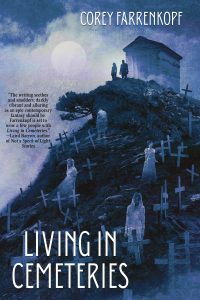
Corey Farrenkopf
JournalStone Publishing (April 19, 2024)
Reviewed by Andrew Byers
Imagine a world superficially similar to our own in which we have absolute proof that ghosts are real because we can all see and interact with them on a daily basis. In this world, we know that all of our loved ones, all of our ancestors, all of our descendants, and ourselves, die and then return as incorporeal spirits able to communicate with the living. How would that change our society? How would it change the course of your own life?
The world of Living in Cemeteries differs in a few key ways from our own. First, ghosts are real, and visible. While it seems clear that there is a kind of afterlife, it is one that I’d mostly describe as a kind of limbo: the spirits of the dead are tied to the locations where their bodies can be buried. They don’t really seem to move on to Heaven or Hell, just mostly stick around on Earth and talk to each other or their descendants. Second, almost every living person seems to be paying off the debts of one of their ancestors. People who die having done something wrong for which they never made amends pass this karmic debt along to a descendant, which means that innocent living people often face terrible punishment meted out by vengeful Spirits (I don’t think these are human, but rather a kind of anthropomorphic cosmic justice). In fact, that’s probably how you’re destined to die. Third, most living people seem to be desperate to find out from ghosts how long they will live, and under what circumstances they will die. Thus, this is a society haunted, quite literally, by the sins of the past. Imagine growing up or living your life knowing that your life will be cut short at an early age, not because of random chance or anything that you yourself have done, but because your grandfather or uncle committed a crime he never atoned for? That leads to the sense of stagnancy and stasis and melancholy that pervades almost all the characters of Living in Cemeteries.
Corey Farrenkopf has set out to explore such a world through the character of Dave Gallagher, a kind of down-on-his-luck everyman who is a groundskeeper at a cemetery in his hometown. Dave’s best friend has just died, but he’s still in close contact with him, in part because he doesn’t want their friendship to die and in part because Dave feels he has as yet unmet obligations to his friend. He’s ostracized from his dead father, who refuses to speak with him about his fate, and none of Dave’s other dead relatives can shed much light either. He’s got a live-in fiancée he loves but he doesn’t want to marry her and have a child with her until he can learn definitively how long he’s got to live. Dave seems stuck in a kind of living limbo.
What makes Living in Cemeteries special is its unique premise and richly imagined world. Farrenkopf effortlessly immerses readers in a world where ghosts roam freely and the line between the past and the present blurs. We might even describe this as a world with very little future, given its relentless focus on the past. With its blend of supernatural elements, heartfelt emotion, and captivating storytelling, it is impossible not to become emotionally invested in Dave’s journey, which is melancholic and tragic and at times, heart-rending. This one stuck with me. Definitely recommended.
- Book Review: BLACK SEAS OF INFINITY - July 24, 2024
- Book Review: THE SECRET LANGUAGE OF SPIDERS - July 3, 2024
- Book Review: GODS OF A NAMELESS COUNTRY - May 2, 2024
- Book Review: LIVING IN CEMETERIES - April 26, 2024
- Book Review: BABYLON TERMINAL - April 22, 2024
- Book Review: ORPHANS OF WONDERLAND - April 8, 2024
- Book Review: CHILDREN OF CHAOS - April 4, 2024
- Book Review: RAZORED LAND - April 2, 2024
- Book Review: FALLS THE DARKNESS - January 29, 2024
- Book Review: DEEP NIGHT - January 25, 2024


